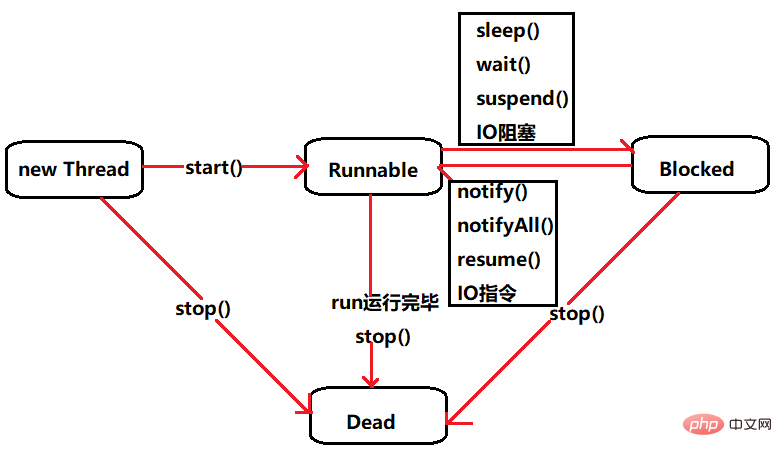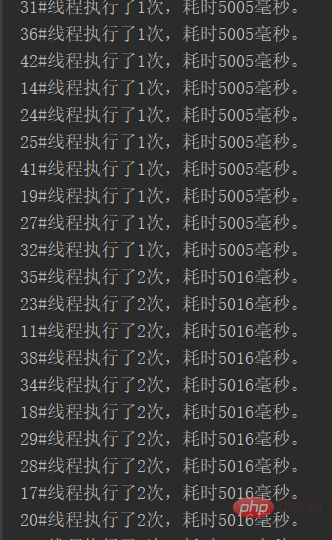Introduction to the life cycle of Java threads (with examples)
This article brings you an introduction to the life cycle of Java threads (with examples). It has certain reference value. Friends in need can refer to it. I hope it will be helpful to you.
1. Thread life cycle
Processes, like threads, have a certain life cycle. The thread life cycle includes four states: creation state, ready state, blocking state, and death state. .
1. Creation state
1) refers to using new to instantiate a thread object, but the thread object has not yet used the start() method to start the thread. This stage is only in the memory. The memory space is allocated for the instance variable of the object in the heap, but the thread cannot participate in grabbing the right to use the CPU;
2) After the thread object is created, the start() method is used to start the thread object, and Not the run() method.
2. Ready state
1) refers to the stage from when a thread object uses the start() method to finishing running the run() method. Once the thread enters the ready stage, the Java virtual machine Create the call stack and counter of the method for the thread;
2) Within a certain unit time (time slice), the CPU can only run one thread. Once a thread has the right to use the CPU, then This thread can also be called the running state;
3) All threads in the ready state are considered active. You can use the isAlive() method to test whether the thread is in the ready state, and use activeCount() to query the current The number of active threads in the thread pool where the thread is located;
4) The thread in the ready state is not in the running state. In the past, many computers were single-processor, and all threads in the ready state must be run at the same time. It is impossible. Java uses some scheduling algorithms to ensure that these threads share the use of the processor (such as time slice rotation algorithm, exclusive algorithm, etc.).
3. Blocking state:
1) The blocking state includes four states (sleep state, blocking state, suspend state, waiting state). Generally speaking, the blocking state and The ready state can be switched between each other;
2) Use the sleep() method to put the thread into sleep state, allowing other processes to get a chance to run, but using the sleep method must capture the InterruptedExecption exception;
3) You can use the suspend method to suspend a thread (obsolete after jdk1.2), use the wait method to put a thread into a waiting state (there will be an essay dedicated to it later), and use I/O interrupts to put a thread into a blocking state.
4. Death state:
1) Once the thread finishes running the run method, the thread enters the death state, and the Java virtual machine destroys the system resources occupied by the thread object in the death state;
2) When the thread encounters an uncaught exception during execution, the thread will be terminated and enter the death state; calling the stop method can also cause the thread to enter the death state, but it is easy to cause deadlock and has been deprecated.
5. The thread life cycle is as follows:

2. The following is a case where the sleep method puts the thread into sleep state
/**
* @author: PrincessHug
* @date: 2019/4/12, 9:20
* @Blog: https://www.cnblogs.com/HelloBigTable/
*/
public class SleepDemo implements Runnable{
@Override
public void run() {
long l;
for (int i=1;i<6;i++){
l = System.currentTimeMillis();
try {
Thread.currentThread().sleep(5000);
} catch (InterruptedException e) {
e.printStackTrace();
}
l = (System.currentTimeMillis() - l);
System.out.println(Thread.currentThread().getName() + "线程执行了" + i + "次,耗时" + l + "毫秒。");
}
}
}
public class SleepDriver {
public static void main(String[] args) {
SleepDemo sd = new SleepDemo();
for (int i=0;i<50;i++){
new Thread(sd,i + "#").start();
}
}
}The following are some screenshots of the running results:

You can see if at the same time The more threads started, the longer each thread will take.
The above is the detailed content of Introduction to the life cycle of Java threads (with examples). For more information, please follow other related articles on the PHP Chinese website!

Hot AI Tools

Undresser.AI Undress
AI-powered app for creating realistic nude photos

AI Clothes Remover
Online AI tool for removing clothes from photos.

Undress AI Tool
Undress images for free

Clothoff.io
AI clothes remover

Video Face Swap
Swap faces in any video effortlessly with our completely free AI face swap tool!

Hot Article

Hot Tools

Notepad++7.3.1
Easy-to-use and free code editor

SublimeText3 Chinese version
Chinese version, very easy to use

Zend Studio 13.0.1
Powerful PHP integrated development environment

Dreamweaver CS6
Visual web development tools

SublimeText3 Mac version
God-level code editing software (SublimeText3)

Hot Topics
 Break or return from Java 8 stream forEach?
Feb 07, 2025 pm 12:09 PM
Break or return from Java 8 stream forEach?
Feb 07, 2025 pm 12:09 PM
Java 8 introduces the Stream API, providing a powerful and expressive way to process data collections. However, a common question when using Stream is: How to break or return from a forEach operation? Traditional loops allow for early interruption or return, but Stream's forEach method does not directly support this method. This article will explain the reasons and explore alternative methods for implementing premature termination in Stream processing systems. Further reading: Java Stream API improvements Understand Stream forEach The forEach method is a terminal operation that performs one operation on each element in the Stream. Its design intention is
 PHP: A Key Language for Web Development
Apr 13, 2025 am 12:08 AM
PHP: A Key Language for Web Development
Apr 13, 2025 am 12:08 AM
PHP is a scripting language widely used on the server side, especially suitable for web development. 1.PHP can embed HTML, process HTTP requests and responses, and supports a variety of databases. 2.PHP is used to generate dynamic web content, process form data, access databases, etc., with strong community support and open source resources. 3. PHP is an interpreted language, and the execution process includes lexical analysis, grammatical analysis, compilation and execution. 4.PHP can be combined with MySQL for advanced applications such as user registration systems. 5. When debugging PHP, you can use functions such as error_reporting() and var_dump(). 6. Optimize PHP code to use caching mechanisms, optimize database queries and use built-in functions. 7
 PHP vs. Python: Understanding the Differences
Apr 11, 2025 am 12:15 AM
PHP vs. Python: Understanding the Differences
Apr 11, 2025 am 12:15 AM
PHP and Python each have their own advantages, and the choice should be based on project requirements. 1.PHP is suitable for web development, with simple syntax and high execution efficiency. 2. Python is suitable for data science and machine learning, with concise syntax and rich libraries.
 PHP vs. Other Languages: A Comparison
Apr 13, 2025 am 12:19 AM
PHP vs. Other Languages: A Comparison
Apr 13, 2025 am 12:19 AM
PHP is suitable for web development, especially in rapid development and processing dynamic content, but is not good at data science and enterprise-level applications. Compared with Python, PHP has more advantages in web development, but is not as good as Python in the field of data science; compared with Java, PHP performs worse in enterprise-level applications, but is more flexible in web development; compared with JavaScript, PHP is more concise in back-end development, but is not as good as JavaScript in front-end development.
 PHP vs. Python: Core Features and Functionality
Apr 13, 2025 am 12:16 AM
PHP vs. Python: Core Features and Functionality
Apr 13, 2025 am 12:16 AM
PHP and Python each have their own advantages and are suitable for different scenarios. 1.PHP is suitable for web development and provides built-in web servers and rich function libraries. 2. Python is suitable for data science and machine learning, with concise syntax and a powerful standard library. When choosing, it should be decided based on project requirements.
 Java Program to Find the Volume of Capsule
Feb 07, 2025 am 11:37 AM
Java Program to Find the Volume of Capsule
Feb 07, 2025 am 11:37 AM
Capsules are three-dimensional geometric figures, composed of a cylinder and a hemisphere at both ends. The volume of the capsule can be calculated by adding the volume of the cylinder and the volume of the hemisphere at both ends. This tutorial will discuss how to calculate the volume of a given capsule in Java using different methods. Capsule volume formula The formula for capsule volume is as follows: Capsule volume = Cylindrical volume Volume Two hemisphere volume in, r: The radius of the hemisphere. h: The height of the cylinder (excluding the hemisphere). Example 1 enter Radius = 5 units Height = 10 units Output Volume = 1570.8 cubic units explain Calculate volume using formula: Volume = π × r2 × h (4
 PHP: The Foundation of Many Websites
Apr 13, 2025 am 12:07 AM
PHP: The Foundation of Many Websites
Apr 13, 2025 am 12:07 AM
The reasons why PHP is the preferred technology stack for many websites include its ease of use, strong community support, and widespread use. 1) Easy to learn and use, suitable for beginners. 2) Have a huge developer community and rich resources. 3) Widely used in WordPress, Drupal and other platforms. 4) Integrate tightly with web servers to simplify development deployment.
 Create the Future: Java Programming for Absolute Beginners
Oct 13, 2024 pm 01:32 PM
Create the Future: Java Programming for Absolute Beginners
Oct 13, 2024 pm 01:32 PM
Java is a popular programming language that can be learned by both beginners and experienced developers. This tutorial starts with basic concepts and progresses through advanced topics. After installing the Java Development Kit, you can practice programming by creating a simple "Hello, World!" program. After you understand the code, use the command prompt to compile and run the program, and "Hello, World!" will be output on the console. Learning Java starts your programming journey, and as your mastery deepens, you can create more complex applications.






